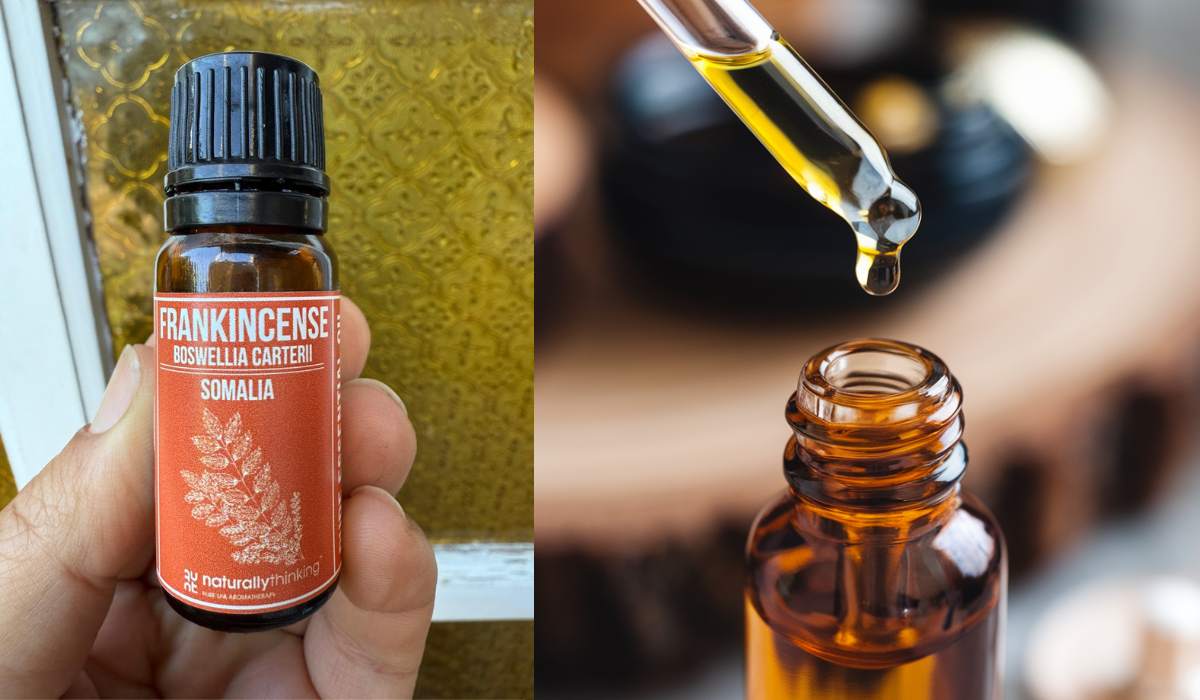5 Dangerous Mistakes People Make with Frankincense Oil
You’ve just unwrapped your brand-new bottle of frankincense oil. Excitement kicks in.
You’ve read about its benefits (heck, I write about these ALL the time!), you’ve planned all the ways you’ll use it, and then—ouch.
Your skin’s tingling, maybe even burning. That glow you were hoping for? It’s nowhere to be seen…
Sound familiar? You’re not alone. A lot of people jump headfirst into using essential oils without understanding the dos and don’ts, and frankincense is no exception.
This “liquid gold” is as powerful as it is versatile, but with great power comes the need for caution.
Here’s the deal: most mistakes with frankincense oil are totally avoidable.
And once you know what to look out for, you’ll wonder how you ever got it wrong in the first place.
So, let’s talk about the five biggest blunders people make—and how to avoid them.
Related Reading: Some fabulous Frankincense essential oil uses!
Mistake 1: Using Frankincense Oil Undiluted – Don’t Let Your Skin Pay the Price
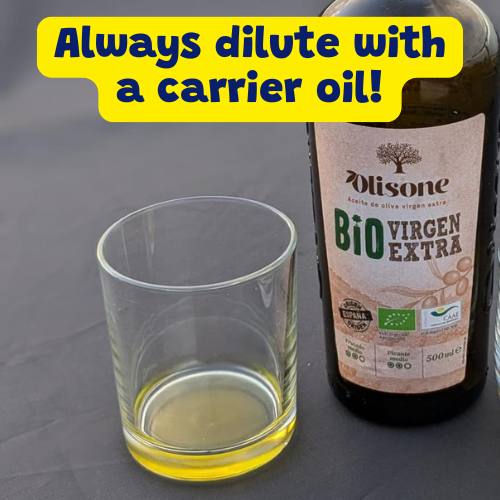
You’re thrilled to finally try your frankincense oil.
It’s been hyped as a skincare saviour, a stress-buster, and even a spiritual game-changer.
You think, What’s the harm in dabbing a little directly onto my skin? And then… the tingle starts. Maybe it’s mild. Maybe it’s not. But that glowing complexion you envisioned? Nowhere in sight.
Frankincense oil is incredibly potent. It’s not meant to be slapped on without a bit of prep. Just like you wouldn’t drink pure lemon juice without wincing, your skin doesn’t want undiluted essential oils, no matter how “natural” they are.
How is this dangerous?
Undiluted essential oils like frankincense aren’t just potent—they’re dangerously strong. Applying it directly to your skin can lead to chemical burns, permanent sensitisation, or even scarring over time. These reactions can make your skin hypersensitive, not just to frankincense but to other essential oils as well. Once sensitisation occurs, there’s no going back—you’ll have to avoid it for life. Don’t take the risk; dilute it properly every time.
How to Get It Right!
👉 Mix it up! Combine 3-5 drops of frankincense oil with a tablespoon of a carrier oil like jojoba or almond oil. This not only makes it safe but helps your skin absorb the benefits without the drama.
Think of it like seasoning your food – too much salt ruins the dish. A little care goes a long way in ensuring your skin gets pampered, not punished.
Related Reading: 5 Wonderful Frankincense Recipes for FLAWLESS Skin!
Mistake 2: Buying the Bargain Bottle
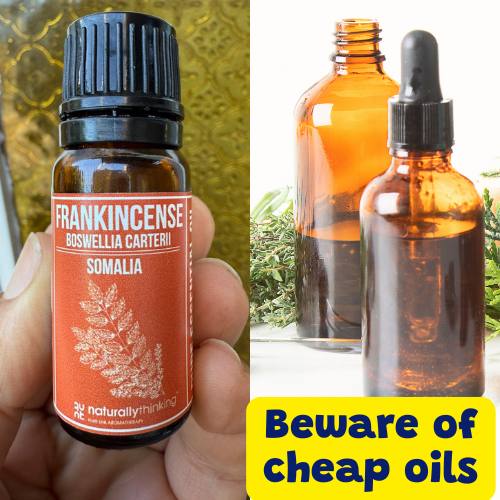
You’re browsing online, excited to snag your first bottle of frankincense oil. Then you spot it: a bottle that’s HALF the price of all the others. What a steal! you think, adding it to your cart without a second thought…
Ok, let’s fast forward to opening it. The scent is… somewhat off (it’s not that rich, grounding aroma you’ve read about). You dilute it properly (see mistake 1) and start using it in your routine, hopeful for the benefits you’ve read about. But after a few weeks, your skin feels off—maybe it’s drier, irritated, or just not showing the results you expected. That’s when it hits you: this “bargain” wasn’t such a great deal after all.
Cheap frankincense oil often means compromised quality. Fillers, synthetic additives, or oils that aren’t 100% pure can irritate your skin and fail to deliver the therapeutic benefits you were hoping for. It’s like buying “designer” perfume from a street stall—it might look convincing, but it’s a far cry from the real thing.
How is this dangerous?
Cheap oils aren’t just ineffective—they can be downright dangerous. Many bargain oils are diluted with synthetic fillers or undisclosed additives that may cause skin irritation, allergic reactions, or even respiratory issues when diffused. Worse, some oils are contaminated with harmful chemicals or pesticides, which could have long-term effects on your health. When it comes to essential oils, you truly get what you pay for—don’t gamble with your wellbeing.
How to Avoid the Regret:
👉 Look for oils labeled as 100% pure and therapeutic grade. Reputable brands often provide sourcing information and testing certificates.
👉 A little goes a long way, so invest in a high-quality bottle. Trust me, it’s worth every penny.
When it comes to frankincense oil, you truly get what you pay for. Don’t let a cheap option compromise your skin or your peace of mind. Go for the real deal, and you’ll thank yourself every time you open that bottle.
Related Reading: The Magic of Frankincense Oil: Your Ultimate Guide to Head-to-Toe Pampering
Mistake 3: Skipping the Patch Test – A Risk You Don’t Want to Take
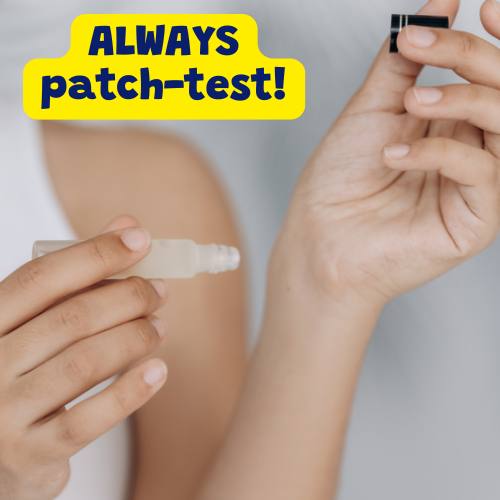
You’re so excited about your new bottle of frankincense oil that you jump right in. A drop in your serum, a touch in your moisturiser, and you’re feeling like a DIY skincare guru.
Then, a few days later, something unexpected happens—redness, irritation, or tiny bumps appear, and you’re left wondering,
Oops!!What went wrong?
You see, even the purest, most natural products can cause reactions. Your skin might not agree with frankincense oil or the way it interacts with other products in your routine.
Skipping the patch test is like rolling the dice—and it’s not worth the gamble.
How is this dangerous?
Ignoring a patch test might seem harmless, but it’s actually a roll of the dice with your skin’s health. Allergic reactions to essential oils can escalate into hives, severe itching, or even difficulty breathing in extreme cases. What starts as mild redness can quickly become a full-blown inflammatory response. Taking just a minute to test beforehand isn’t just a suggestion—it’s a safeguard against serious discomfort or worse!
How to Play It Safe:
👉 Dilute a drop of frankincense oil with a carrier oil and apply it to a small area of skin (like your inner arm).
👉 Wait 24 hours. If there’s no redness, itching, or irritation, you’re good to go.
IT IS REALLY THAT SIMPLE.
A patch test takes less than a minute, but it can save you days of discomfort.
Related Reading: My 2 Favourite Ways of Using Frankincense for Wrinkles
Mistake 4: Neglecting Storage – Your Oil Deserves Better
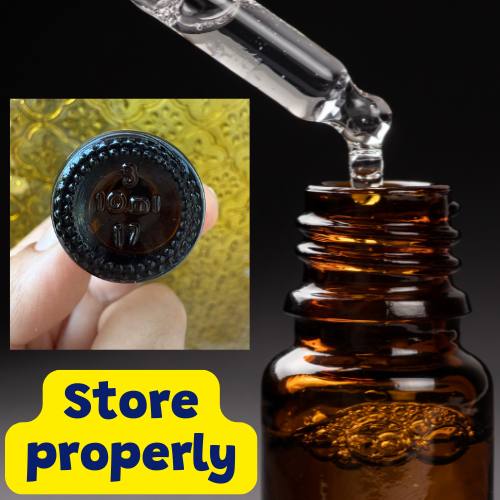
After splurging on that great frankincense essential oil bottle, you start using it, loving it, and then popping it on a sunny windowsill or toss it in a bathroom drawer without a second thought…
Weeks later, something’s changed. The scent seems weaker, or the oil feels off.
Why? frankincense oil is SENSITIVE to light, heat, and air. Improper storage can degrade its quality, leaving you with an oil that’s far less effective (and far less luxurious).
What a waste of money!!
How is this dangerous?
Storing frankincense oil improperly isn’t just a waste of money—it can make the oil unsafe to use. Heat, light, and air exposure can cause oxidation, leading to degraded compounds that may irritate your skin or make the oil ineffective. In some cases, oxidised oils can even trigger allergic reactions that wouldn’t happen with fresh oils. Treat your frankincense like the precious investment it is, or risk wasting it entirely.
Here’s How to Keep It Fresh and Fabulous:
👉 Store your oil in an amber glass bottle to shield it from light.
👉 Keep it in a cool, dark place—think a cupboard, not the windowsill.
👉 Tighten the cap after every use to limit air exposure. When I say every time that means you finish using it, you cap it!!
This way your frankincense oil will stay potent and effective, delivering those therapeutic benefits you paid for.
Related Reading: Benefit of Frankincense Oil on Face
Mistake 5: Overloading Your Blends – When More Is Too Much
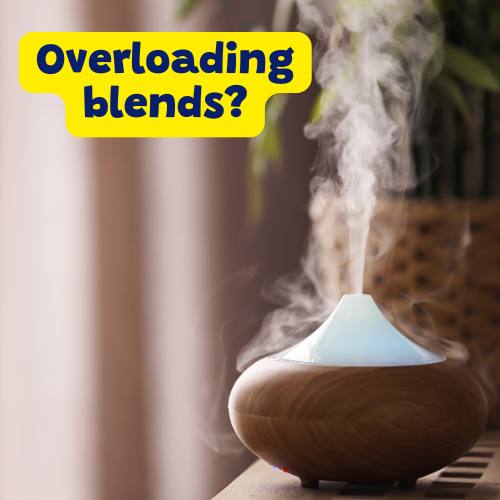
You’ve got your diffuser ready, a blend of essential oils in hand, and you’re aiming for the perfect aroma to fill your space.
Naturally, you think, Frankincense is amazing, so more must be better! A few drops become several, and suddenly, the scent is overpowering, not soothing.
Frankincense is a powerful oil, and its intensity can easily take over if you’re not careful. Instead of enhancing your blend, it can dominate it, leaving no room for the other oils to shine.
How is this dangerous?
Too much frankincense in a blend doesn’t just overpower other scents—it can overwhelm your body. Overexposure to concentrated essential oils can lead to nausea, headaches, or even dizziness, especially in small or poorly ventilated spaces. And if you’re applying the blend to your skin, the risk of irritation increases with every extra drop. Essential oils are powerful tools, but only when used sparingly and with balance.
How to Get It Right!
👉 Start small. Add one or two drops of frankincense and build from there. Let your nose guide you—it’s your best tool for creating balance.
👉 Think of blends like a symphony: each oil should play its part without overwhelming the others.
When done right, frankincense can elevate your blends into something truly special. But remember, in aromatherapy, less is often more. Let the synergy between oils create harmony, not a single overpowering note.
Related Reading: Benefits of Frankincense Essential Oil in Diffuser and Frankincense Essential Oil Blends: Diffuser Recipes & Aromatherapy Magic
Add a Little Frankincense Magic to Your Skincare
Frankincense oil is like a little bottle of skincare magic.
It’s known for helping tired skin feel fresher, calming redness, and giving a bit of extra love to dry patches.
Add a drop or two to your favourite moisturiser, and you’ve instantly got a nourishing upgrade.
Or whip up a simple face mask with ingredients like aloe vera or oatmeal and let frankincense do its thing.
It’s not about overhauling your whole routine—it’s about small, thoughtful steps that make a big difference.
If not sure how to get started, check out my 104 DIY Skincare Recipes with Frankincense Oil. Take your time, read through, plan your routine, start small, implement changes, enjoy the effects that this oil gives over time.
Going natural and using essential oils for skincare not flashy and it definitely doesn’t have to be complicated. It is just effective, natural care that works quietly in the background. And, yes, it does work.
Understanding Frankincense: Picking the Right Type for Your Needs
Not all frankincense oils are created equal—this might surprise you, but it’s true.
That little bottle of “liquid gold” can come from different species of the Boswellia tree, and each one has unique benefits.
Let’s break it down. If you’re looking for anti-inflammatory properties, Boswellia Serrata is your go-to—it’s perfect for calming irritated skin or soothing joint discomfort. On the other hand, Boswellia Carteri is celebrated for its rich, grounding scent, making it the star of aromatherapy and meditation blends (I use it for skincare as well because of its soothing and rejuvenating properties. Check my article on: Is Frankincense the Best Anti-Aging Essential Oil? 4 Reasons Why!)
The trick is knowing what you need and choosing the right type for the task.
Check the label before you buy. Quality brands will clearly state the species, helping you make an informed choice and get the most out of your frankincense oil.
I wrote this article which will be helpful in this regard: The 4 Types of Frankincense Oil. Which One’s For You?. Check it out so you can choose your perfect frankincense essential oil.
Wrapping it Up
Frankincense oil has become one of those little things in my life that I truly value. But I’ll be honest—it took me some time to get it right. Not just with frankincense, but with essential oils in general! From figuring out dilution to learning (the hard way) about proper storage, I’ve probably made every mistake on this list.
That’s why I wanted to share this with you. Because once you get the hang of it, frankincense becomes so much more than just an oil—it’s a ritual, a tiny moment of care in your day. And because I want you to start switching to natural ingredients. It has taken me quite a few years, it’s a learning process! So don’t worry about making the switch overnight. It doesn’t work that way, be patient!
If you’re just starting out with frankincense essential oil or trying to make better use of it, don’t overthink it.
Start small. Test, tweak, and let it fit naturally into your routine.
And most importantly, enjoy the process—it’s part of what makes it so special.

